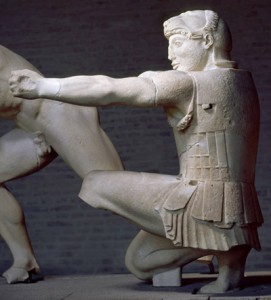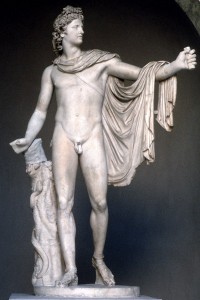Chapter Seven: Transcendental Art
‘After [the 15th century masters] their successors were enabled to attain [the perfection and bloom of art] through seeing excavated out of the earth certain antiquities cited by Pliny as amongst the most famous, such as the Laocoon, the Hercules, the Great Torso of the Belvedere, and likewise the Venus, the Cleopatra, the Apollo, and an endless number of others, which, both with their sweetness and their severity, with their fleshy roundness copied from the greatest beauties of nature, and with certain attitudes which involve no distortion of the whole figure but only a movement of certain parts, and are revealed with a most perfect grace…’ Giorgio Vasari, The Lives of the most Excellent Italian Painters, etc. (1568), preface to Part 3
For three centuries after Vasari wrote this passage, classical sculpture was prized not only for its own supreme merits, but also for supplying modern painters and sculptors with exemplary models to emulate (fig. 7.1). Students in the academies of Europe from the 17th to the early 20th centuries were required to draw plaster casts of these marbles, both to develop their drawing skills and to form a taste for the ‘ideal’. When J.J. Winckelmann published his History of the Art of Antiquity (1764) – the book that established the modern use of ‘art’ as a shorthand for painting and sculpture – he took the classical sculpture of Rome as its embodiment.
The value of those Roman works was challenged in 1806, when Lord Elgin brought the Parthenon sculptures from Athens to London. These astonishing marble figures were too closely observed to be ‘ideal’, yet too magnificent to represent ‘real’ people. Their godlike power and beauty exposed the ancient statues of Rome as semi-mechanical copies.
‘Winckelmann’s assumptions, on which Romantic philosophers had built their aesthetics, were looking decidedly shaky even before twentieth-century modernists rejected classical antiquity as an exemplar tout court. Quality does not inhere in an imagined Idea embodied in classical sculpture, even when observers respond to it ‘aesthetically’. Quality describes a relationship, and if we direct our attention only to one side or other of that bond, it always eludes us.’ —The Truth about Art, p. 118.

Fig. 7.2, Kneeling Herakles drawing his bow, from the temple of Aphaia at Aegina, 490–475 BCE (Munich, Glyptothek); the crisp features, pleasing patterns, and taut energy of archaic sculptures such as this supplied the schemata which later Greek sculptors adjusted to create their classical works. They knew nothing of Plato’s Ideas.
Unaware of the challenge posed by the Elgin marbles to the ‘ideal’ interpretation of Greek sculpture, G.W.F. Hegel followed the traditional view to formulate the modern concept of transcendental Art. In his influential Lectures on Aesthetics delivered in Berlin in the 1820s, Hegel conceived of a ‘world-spirit’ grappling with Platonic Ideas in successive ages, with increasing degrees of success. The Idea found its complete embodiment in Greek sculpture, which was ‘spirituality given shape, the Ideal, and, more precisely, absolute spirit, the truth itself’. With the advent of Christianity, Hegel continued, the Idea retreated from the tangible into the higher perfection of Romantic Art. The three natural Romantic arts are painting, music and poetry, each progressively disentangling itself from matter.
When Gombrich began The Story of Art with the words ‘There really is no such thing as Art. …Art with a capital A has no existence’, it was to Hegel’s Art that he was referring. Few art historians today read Hegel’s Lectures on Aesthetics, yet it is from them that our notion of transcendental Art comes.
< Previous Chapter | Next Chapter >


Thank you for these encouraging words. I’m relieved that a site that stresses the importance of Quality is an ‘excellent read!’.